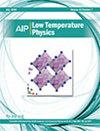Advantages of the low-temperature secondary emission mass spectrometry in analysis of metal ions in water samples revisited
IF 0.8
4区 物理与天体物理
Q4 PHYSICS, APPLIED
引用次数: 0
Abstract
A problem of necessity of concentrating trace admixtures of metal ions required for ecological water analysis can be overcome by harnessing a physical phenomenon of phase separation in aqueous solutions during their freezing. It is shown that the accumulation of metal-containing solutes in the channels between ice crystallites in the frozen solids is sufficient for their successful detection by means of low-temperature secondary emission mass spectrometry. Sufficiency of microliters volumes of water is an advantage of such an approach. Observation of various types of metal ions in frozen water samples is demonstrated on the examples of tap water, sea water, snow and a medicinal preparation. Revisiting and summation of physical basics of mass spectrometric examining of frozen water-inorganic salt solutions and estimates of advancement of mass spectrometric instrumentation permit us to propose a workflow for accelerated and simplified mass spectrometric detection of metal pollutants in water.再论低温二次发射质谱法分析水样中金属离子的优势
生态水分析所需的痕量金属离子混合物的浓缩问题可以通过利用水溶液在冷冻过程中的相分离物理现象来解决。研究表明,含金属溶质在冷冻固体冰晶之间的通道中的积累足以使低温二次发射质谱法成功地检测到这些溶质。这种方法的一个优点是只需微升量的水。以自来水、海水、雪和一种药物制剂为例,展示了对冷冻水样品中各种金属离子的观察。通过对冷冻水-无机盐溶液质谱检测的物理基础知识的回顾和总结,以及对质谱仪器发展的估计,我们提出了一种加快和简化水中金属污染物质谱检测的工作流程。
本文章由计算机程序翻译,如有差异,请以英文原文为准。
求助全文
约1分钟内获得全文
求助全文
来源期刊

Low Temperature Physics
物理-物理:应用
CiteScore
1.20
自引率
25.00%
发文量
138
审稿时长
3 months
期刊介绍:
Guided by an international editorial board, Low Temperature Physics (LTP) communicates the results of important experimental and theoretical studies conducted at low temperatures. LTP offers key work in such areas as superconductivity, magnetism, lattice dynamics, quantum liquids and crystals, cryocrystals, low-dimensional and disordered systems, electronic properties of normal metals and alloys, and critical phenomena. The journal publishes original articles on new experimental and theoretical results as well as review articles, brief communications, memoirs, and biographies.
Low Temperature Physics, a translation of the copyrighted Journal FIZIKA NIZKIKH TEMPERATUR, is a monthly journal containing English reports of current research in the field of the low temperature physics. The translation began with the 1975 issues. One volume is published annually beginning with the January issues.
 求助内容:
求助内容: 应助结果提醒方式:
应助结果提醒方式:


